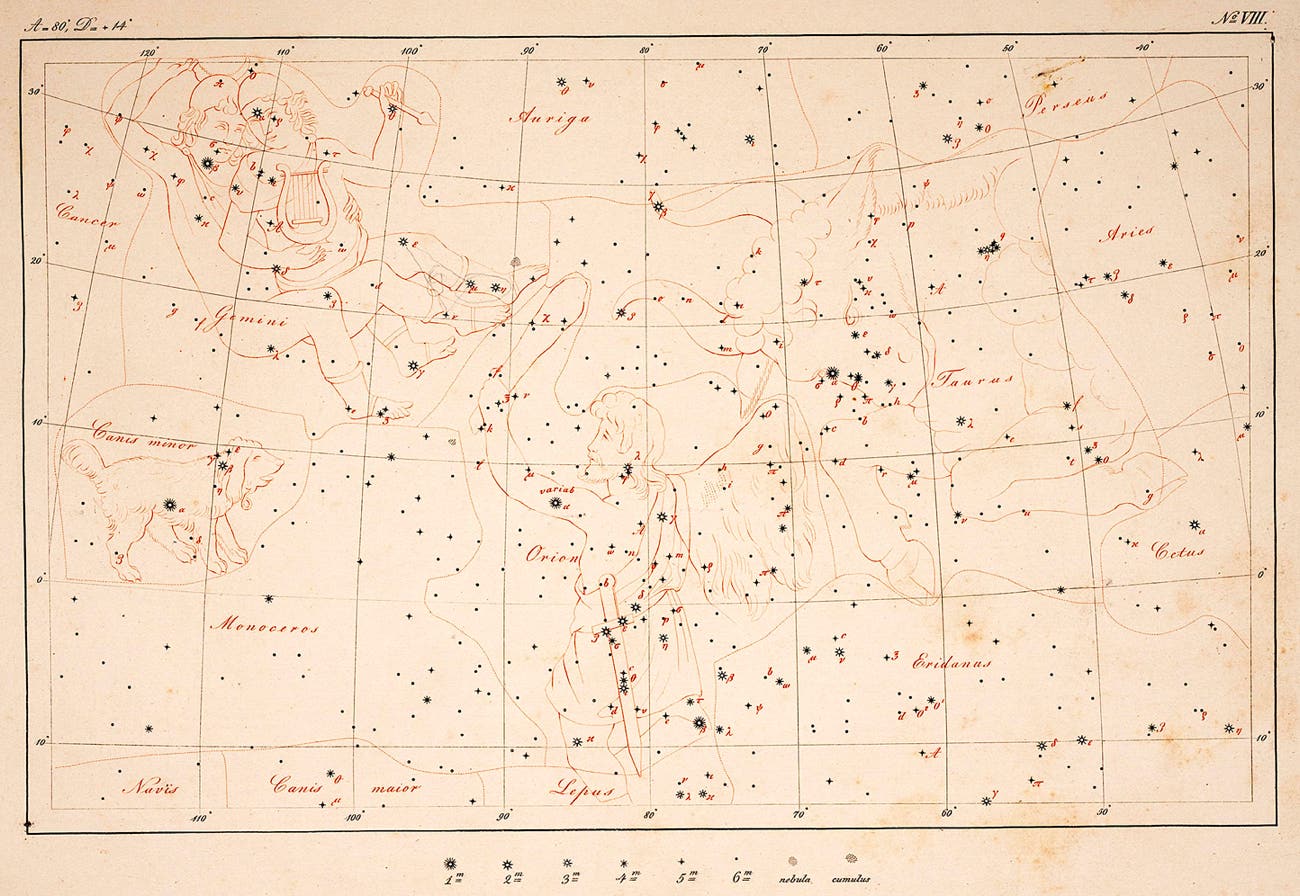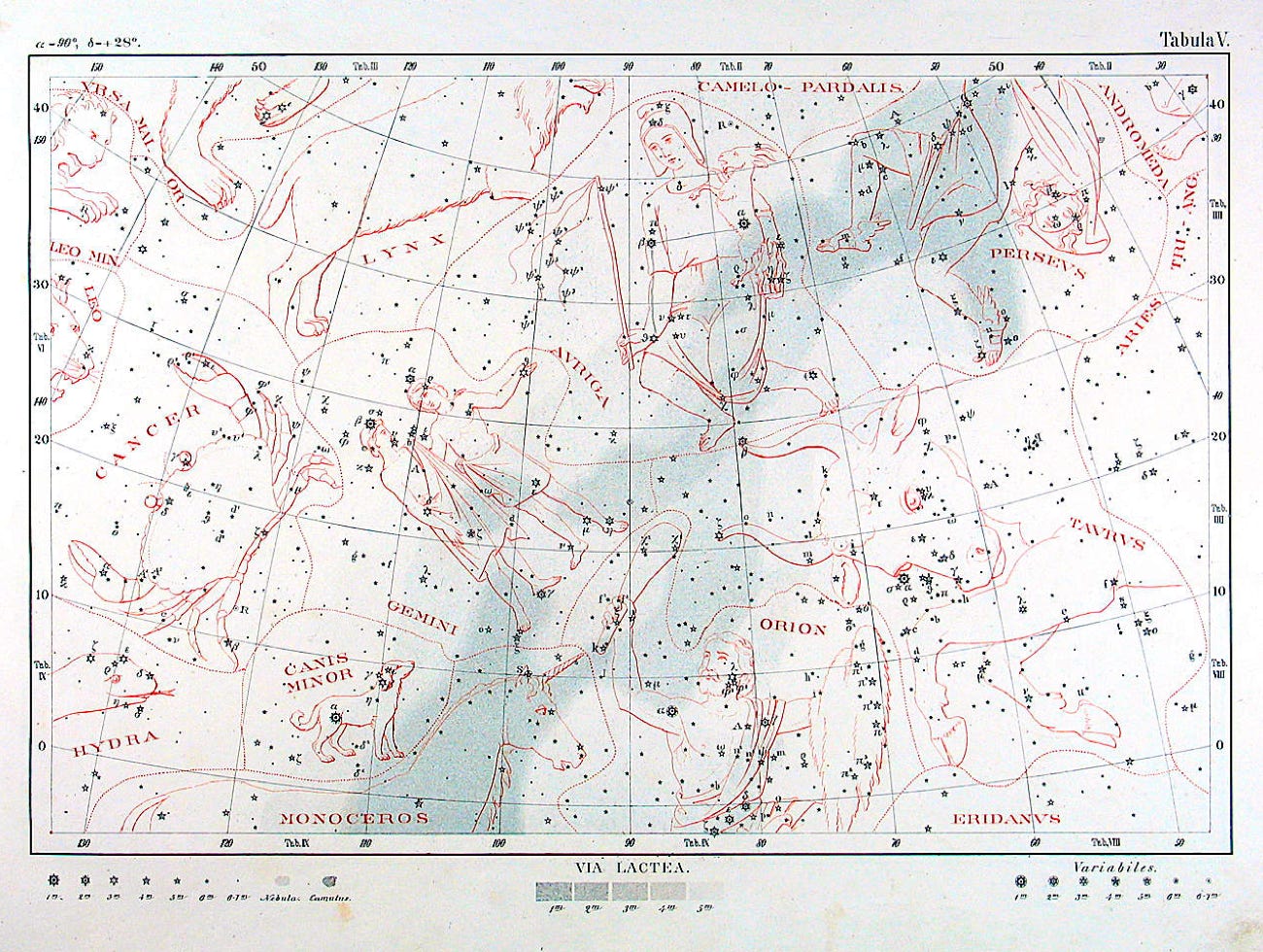The Uranometria Nova of F. W. A. Argelander
and the Atlas Coelestis Novus of Eduard Heis
Argelander's Uranometria Nova atlas of 1843 was printed in two colours, with the stars and coordinate lines in black and the constellation figures and boundaries in red. The outline constellation figures were based on the engravings in Bayer's original Uranometria of 1603. In many copies the red ink has faded over time and become brownish.
Friedrich Wilhelm August Argelander (1799–1875), Prussian-born German astronomer and inaugural director of Bonn Observatory, is probably best-known for his monumental Bonner Durchmusterung, a catalogue of 324,198 stars down to 9th magnitude from the north celestial pole to declination 2° south, published in three volumes in 1859–62. However, a lesser-known work of his is also worthy of recognition because of its influence on our current constellation system: his semi-popular atlas and catalogue of naked-eye stars called Uranometria Nova of 1843, also known by its German title Neue Uranometrie. Argelander’s use of the name Uranometria was a homage to the pioneering atlas of the same name by his fellow German Johann Bayer over 200 years earlier.
Argelander’s Uranometria Nova
Uranometria Nova came about somewhat by chance. When Argelander was appointed director at Bonn in 1836 there was as yet no observatory for him to occupy and no instruments to work with. While waiting for them to be completed he compiled a catalogue of naked-eye stars down to declination –37°, which was as far south as he could reasonably see from Bonn. His listing contained 3,256 objects in all, some 50 per cent more than in Bayer’s original Uranometria. Argelander estimated the brightness of each of them to the nearest third of a magnitude (he used the notation: 1; 1-2; 2-1; 2; and so on, down to magnitude 6), while positions came from various existing catalogues, updated to 1840.[note]
Most significantly from a historical point of view, he divided his stars into 57 constellations (see Table). These included all the Ptolemaic constellations except Ara and Corona Australis, which were too far south for him to see; seven of Hevelius’s inventions (Canes Venatici, Lacerta, Leo Minor, Lynx, Scutum, Sextans, Vulpecula); three of Petrus Plancius (Camelopardalis, Columba, Monoceros); plus Coma Berenices which had been introduced by another German, Caspar Vopel, in the 16th century.
Table: The 57 constellations listed by F. W. A. Argelander in his Uranometria Nova catalogue (1843)
Andromeda
Aquarius
Aquila et Antinous
Argo Navis
Aries
Auriga
Boötes
Camelopardalus *
Cancer
Canes Venatici
Canis Major
Canis Minor
Capricornus
Cassiopeia
Centaurus
Cepheus
Cetus
Columba
Coma Berenices
Corona Borealis
Corvus
Crater
Cygnus
Delphinus
Draco
Equuleus
Eridanus
Gemini
Hercules
Hydra
Lacerta
Leo
Leo Minor
Lepus
Libra
Lupus
Lynx
Lyra
Monoceros
Ophiuchus
Orion
Pegasus
Perseus
Pisces
Piscis Austrinus
Sagitta
Sagittarius
Scorpius
Scutum Sobiesii (sic)
Serpens
Sextans
Taurus
Triangulum
Ursa Major
Ursa Minor
Virgo
Vulpecula cum Ansere
* spelling corrected by Heis to Camelopardalis
Uranometria Nova atlas and constellation images
Argelander’s accompanying atlas plotted his catalogued stars on 16 plates measuring 31 x 20 cm (12.2 x 7.9 inches); a 17th chart covered the southern sky that was beneath his horizon. This southern chart included the constellations shown on Lacaille’s southern planisphere of 1756 plus, for some reason, Bode’s invention Machina Electrica, the only one on the chart that was not eventually adopted by the International Astronomical Union.
Bayer’s charts in the original Uranometria featured highly exaggerated star images and elaborate engravings of the constellation figures but Argelander’s approach was more restrained, with realistic star images and constellation figures reduced to bare outlines, although still based on Bayer’s original imagery. It had the unusual feature of being printed in two colours, the constellation figures and their boundaries in red and the stars in black. The red lines would have vanished under the red light favoured by observers to preserve their night vision, leaving only the black stars visible. The single southern chart did not have pictorial representations of the constellations, just their names and snaking boundaries.
Eduard Heis and the Atlas Coelestis Novus
Nearly 30 years after the appearance of Argelander’s Uranometria Nova another German, Eduard Heis (1806–77), published a follow-up called Atlas Coelestis Novus (or Neuer Himmels-Atlas in German). Heis, unlike Argelander, was not a professional astronomer but a teacher of mathematics and physics, first at Aachen and then Münster. His main interests were the naked-eye observation of meteors, variable stars, aurorae, and the zodiacal light.
Inspired by Argelander’s Uranometria Nova, Heis began his own survey of naked-eye stars. His catalogue, 27 years in the making, was published in 1872. It contained 5,421 objects (including some clusters and nebulae), 2,165 more than Argelander. Most of the additional stars were at the fainter end of the magnitude range, for Heis had unusually sensitive eyesight that enabled him to see fainter stars than most observers (he could, for example, distinguish 11 members of the Pleiades). He arranged his stars into the same 57 constellations as had Argelander.
Heis’s accompanying atlas consisted of 12 charts of the sky visible from Germany (there was no chart of the southern sky).[note] The plates were slightly larger than Argelander’s, 33 x 21½ cm (13 x 8½ inches). As in Argelander’s atlas, the constellation figures were printed in red, but whereas Argelander based his constellation figures on those of Bayer, Heis modelled his on the ancient globe known as the Farnese atlas. One improvement over Argelander’s atlas was that Heis included a realistic depiction of the Milky Way from his own observations.
The atlases and catalogues of Argelander and Heis were popular with observers of the day, both amateur and professional, but perhaps their most lasting contribution was that their choice of constellations, combined with the southern selection in Benjamin A. Gould’s Uranometria Argentina, formed the basis for the final list of 88 constellations adopted by the IAU in 1922.
The charts in Eduard Heis’s Atlas Coelestis Novus of 1872 followed Argelander’s two-colour style but with different constellation images and the addition of a realistic depiction of the Milky Way from Heis’s own naked-eye observations.
© Ian Ridpath. All rights reserved
This was before the widespread use of photometers that could give brightness estimates accurate to about a tenth of a magnitude. The first major catalogue compiled with the use of such a photometer was the Harvard Photometry of 1884, listing 4,260 stars north of declination –30°. This was superseded by the all-sky Revised Harvard Photometry (HR) of 1908. Visual photometry was itself soon supplanted by photographic photometry.
A third German, Carl Behrmann (1843–1927), published the Atlas des südlichen gestirnten Himmels in 1874, two years after Heis, covering the sky from declination –20° to the south celestial pole. Behrmann’s accompanying catalogue contained 2,328 stars plus some clusters and nebulae. However, his magnitude estimates, made during a ten-month voyage in the southern hemisphere in 1866–67, were unreliable, and his atlas and catalogue were soon superseded by Benjamin Gould’s Uranometria Argentina of 1877.

